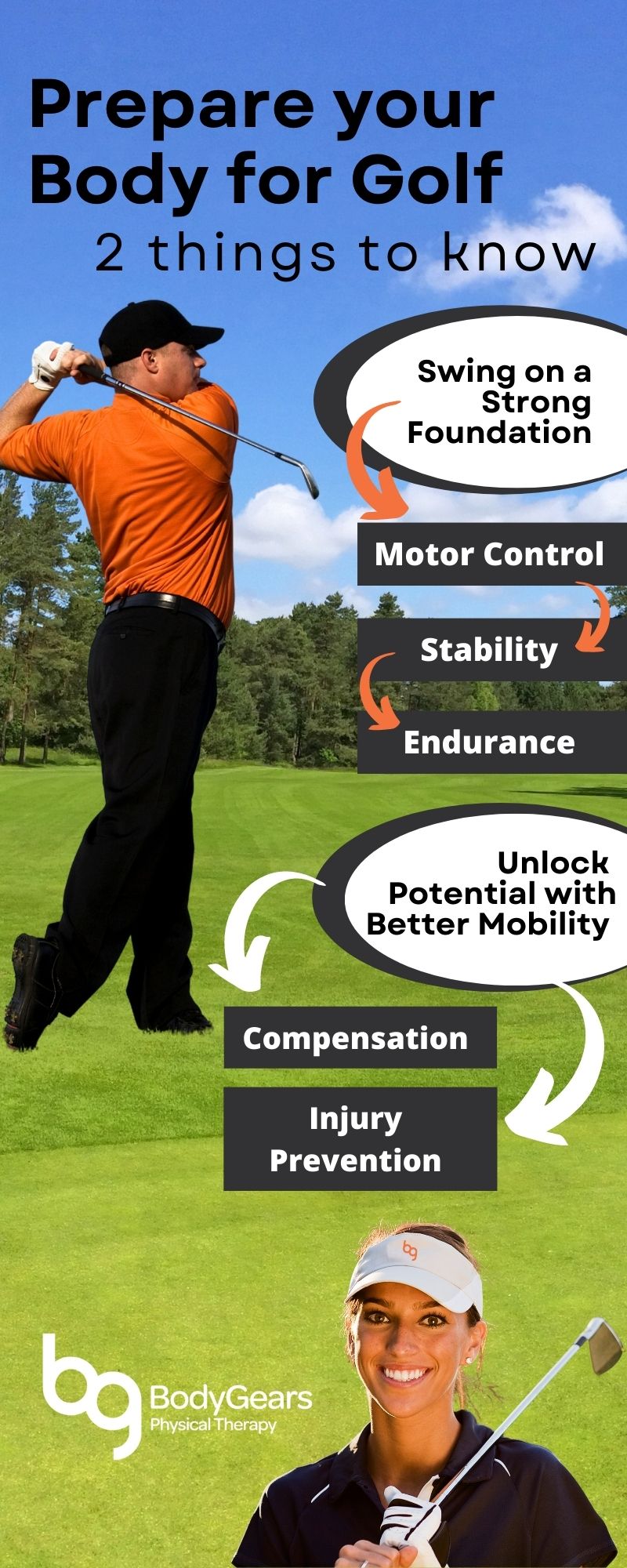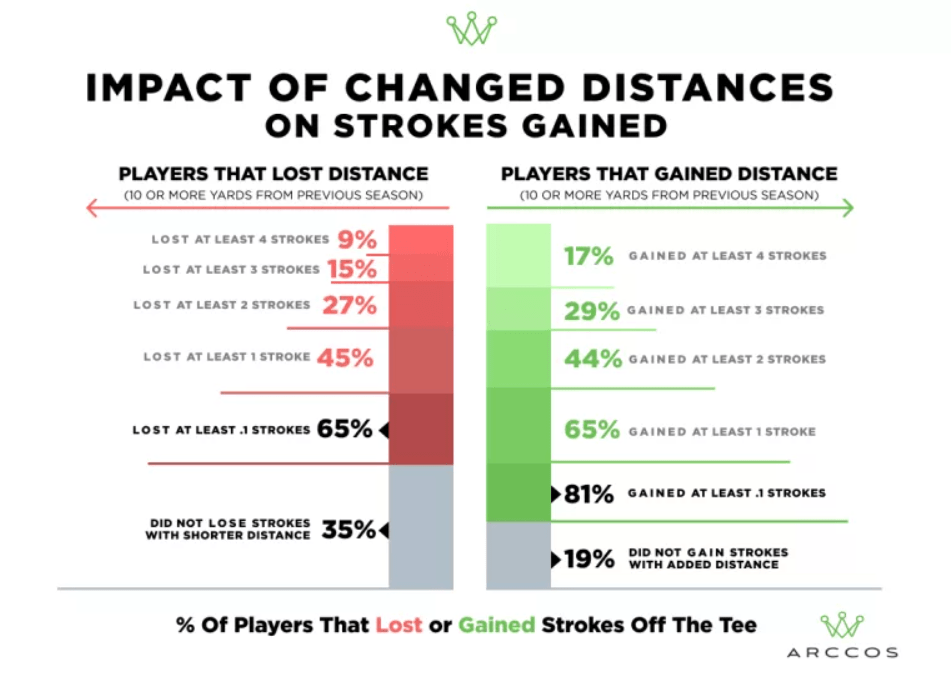Many golfers find themselves swinging through pain as they start the season. This is a result of not preparing your body accordingly for golf.

Cody Lindsey, Regional Manager and Physical Therapist with Body Gears Physical Therapy, says there are two things to know about preparing your body for golf;
- Swinging on a strong foundation
- Unlocking potential with improved mobility
“Golf is a game of repetitive motions. Common golf injuries are a result of this repetition. Golfers who implement strength and mobility training can prevent injury and improve their performance on the course.“
– Cody Lindsey, PT, DPT
Swinging on a Strong Foundation
It is no secret that strength is associated with hitting distance. In theory, the stronger the force behind a swing, the farther the ball travels.
Studies show that stronger golfers are not only hitting the ball further, they are actually scoring better on top of it. This is due to the positive effects of strength training on motor control, stability, and endurance.
According to Golf Monthly and Arccos, 81% of golfers who added 10+ yards off the tee improved their average strokes gained total per round. Total strokes gained per round improved by an average of 1.80.
Professional golfers provide a great example of swinging on a strong foundation. Although we may not go pro, training programs that strengthen our foundation will improve our game.
Let’s dive deeper into the effects of motor control, stability, and endurance.
Motor Control
According to Cody Lindsey, “Motor control is the ability to coordinate and regulate intended movement patterns.”
This is of high importance for golfers. Strengthening golf swing movement patterns improves motor control. This allows golfers to have a better feel for their swing and make adjustments to mechanics.
Stability
The golf swing is dynamic in nature. Stability helps to resist unnecessary movement. It also helps to maintain center of gravity. These are key to improving performance.
The strength in a golfer’s legs, core, and upper body provides a stable base of support for the golf swing. In turn, this adds efficiency and reliability. This improves striking consistency.
Golfers who lack stability will feel off balance. This can lead to poor body control during the swing.
Stability deficits can result in inconsistent swing patterns and missed shots.. and frustrating rounds!
Endurance
As an added bonus, stronger golfers have better endurance and are less prone to injury.
Weight training builds resiliency in muscles, ligaments, tendons, bones, and other connective tissue. Other areas, such as your forearm muscles, will also strengthen as a result of weight training. This will help you grip the club and reduce risk of overuse injuries like wrist injuries, golfers elbow and tennis elbow.
A stronger golfer can endure more strain on their body without breaking down. This translates to being able to take more swings and walk the course with less fatigue.
Strengthening the legs and core with exercises like squats, planks, and resisted trunk rotation are great for most golfers. Easy to find equipment such as resistance bands, dumbbells, and medicine balls will help your golf strength and endurance.
“By exercising, golfers can expect a more consistent, fatigue-resistant swing pattern.”
– Cody Lindsey, PT, DPT

Unlock Potential with Improved
Mobility
Healthy movement patterns require a balance of mobility and stability. Range of motion is key to optimizing mobility. Without the healthy balance of mobility and stability we will compensate to perform movements as ‘desired.’
Range of Motion
Mobility is the ability of a body part or segment to go through a given range of motion (ROM). It is thought of as a blend of flexibility and stability.
“Lack of mobility makes the golf swing less efficient and consistent. This, in turn, wreaks havoc on the score sheet.”
– Cody Lindsey, PT, DPT
Mobility comes into play when evaluating golf swing mechanics.
For example:
A golfer may be told he needs to improve hip “flexibility.” This would make sense if the swing appears to lack hip rotation.
But what if he doesn’t lack adequate hip flexibility? This points to a lack of stability to support his ROM during the golf swing.
Regardless of the reason, such impairments can produce a golf swing that lacks mobility in the hips. Until measures are taken to correct the deficit the golfer can only attempt to compensate with swing alterations.
Compensation
An ideal golf swing demands different range of motion requirements. This is required in various segments of the body.
Restrictions in joint movement and muscle flexibility lead to compensation patterns developing during the swing. This is the reason we see so many interesting swing techniques on our local golf courses.
For example:
Limitations in shoulder mobility can cause golfers to “wing” their trail arm during the back swing.
This makes it difficult to keep the golf club on a smooth swing path. This may also contribute to lifting the trunk during the back swing.
Similarly, limitations in back, hip, elbows, wrists, and other parts of the body also cause faulty swing mechanics.
Compensating around major joints during repetitive movement activities also increases our risk of injury. The rotator cuff of the shoulder joint is a common place to compensate around and incur injury as a result.
“In golf, when we over swing we enter a range of motion the body cannot manage. Pushing our body beyond movement capacities increases our risk of injury further.”
– Cody Lindsey, PT, DPT
Injury prevention
A simple start to injury prevention is a 10-minute warm-up routine before playing golf. A warmup may include taking light swings, brisk walking, or dynamic leg and trunk stretches.
Many golfers already experience common types of injuries in their lower body and back. For those with lower back, knee, or foot and ankle injuries, it is especially important to prepare with a proper warmup session.
Studies suggest that warming up reduces injury rates by as much as 50%. If a short warm-up can have such great effects, imagine the benefit of performing such a routine on a regular basis.
Although we cannot all aspire to be the next Tiger Woods, we can optimize our body’s movement potential. Have questions, reach out to your local physical therapist or sports medicine specialist.
Physical therapists and athletic trainers are your best resources for optimizing the potential of your body and golf game.
There is a lot that goes into hitting that little, white golf ball. Give yourself an advantage with a strong foundation and healthy mobility.
Tags: physical therapy, injury prevention, performance, golf






